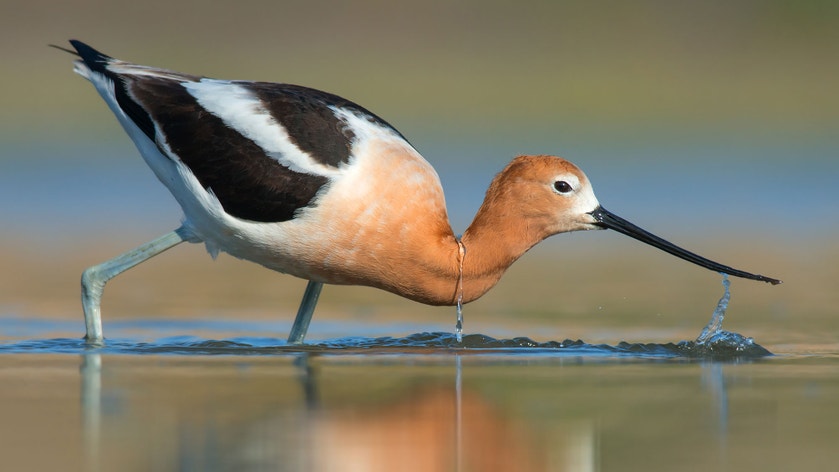American Avocet
At a Glance
Around lake shores and tidal flats, especially in the wide-open spaces of the west, flocks of elegant American Avocets wade in the shallows. They often feed while leaning forward, with the tips of their bills in the water and slightly open, filtering tiny food items from just below the surface. Sometimes a flock will feed this way in unison, walking forward, swinging their heads rhythmically from side to side.
All bird guide text and rangemaps adapted from Lives of North American Birds by Kenn Kaufman© 1996, used by permission of Houghton Mifflin Harcourt Publishing Company. All rights reserved.
Category
Sandpiper-like Birds
IUCN Status
Least Concern
Habitat
Coasts and Shorelines, Freshwater Wetlands, Lakes, Ponds, and Rivers, Saltwater Wetlands
Region
California, Eastern Canada, Florida, Great Lakes, Mid Atlantic, New England, Northwest, Plains, Rocky Mountains, Southeast, Southwest, Texas, Western Canada
Behavior
Direct Flight, Running
Population
460.000
Range & Identification
Migration & Range Maps
Most migrate to the coast (or to valleys of California) in winter. Some migrate well to the east, wintering along much of Atlantic Coast, with flocks of nonbreeders remaining through the summer there.
Description
18" (46 cm). Slender and graceful with long, blue-gray legs, upcurved bill (more strongly curved in female). Bold black-and-white pattern on back and wings. Head and neck pale cinnamon in summer, gray in winter.
Size
About the size of a Crow, About the size of a Mallard or Herring Gull
Color
Black, Gray, White, Yellow
Wing Shape
Broad, Pointed, Tapered
Tail Shape
Short
Songs and Calls
A loud repeated wheep.
Call Pattern
Falling, Flat
Call Type
Raucous, Scream, Whistle
Habitat
Beaches, flats, shallow lakes, prairie ponds. Widespread on shallow waters and extensive mudflats, both along coast and in the interior. Typically in very open situations, with little vegetation. Inland, often favors salty or alkaline lakes more than fresh waters.
Sign up for Audubon's newsletter to learn more about birds like the American Avocet
Behavior
Eggs
4, sometimes 3-5. Olive-buff, blotched with brown and black. Incubation is by both parents, 23-25 days. Female incubates at night, both sexes take turns during day.
Young
Downy young leave nest soon after hatching, find all their own food. Both parents tend young. Age at first flight about 4-5 weeks.
Feeding Behavior
Forages in a variety of ways. Often sweeps head from side to side, with upturned tip of bill barely submerged in shallow water, finding food by touch. Also finds food visually, picking items from surface of water or mud, or plunging head into water; sometimes snatches flying insects as they pass.
Diet
Mostly small crustaceans and insects, also some seeds. Feeds on abundant tiny creatures that live in or near shallow water. Diet includes many midge larvae and other aquatic insects, small crustaceans. On lakes in west may feed heavily on brine shrimp and brine flies.
Nesting
Typically nests in loose colonies, sometimes mixed with Black-necked Stilts. If predators approach a colony on foot, several adults may perform a distraction display nearby, running about in a crouch with both wings spread. If eggs or young are directly threatened, adult avocets may fly straight at an intruder, calling loudly. Nest site is on bare open ground, not far from water. Nest (built by both sexes) may be a simple scrape in soil, or scrape lined with pebbles and other debris, or a mound built up to more than a foot tall.
Conservation
Conservation Status
Population probably stable or possibly increasing. Numbers occurring in east (as migrants and wintering birds) have increased greatly during recent decades. Undoubtedly vulnerable to the effects of climate change, which are likely to cause major changes to western wetlands.
Climate Threats Facing the American Avocet
Choose a temperature scenario below to see which threats will affect this species as warming increases. The same climate change-driven threats that put birds at risk will affect other wildlife and people, too.










